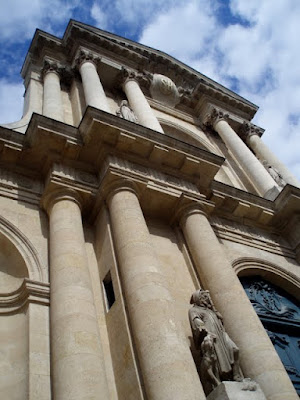 |
| Claude Monet Matin |
 |
| Reflets Verts |
 |
| Soleil Couchant |
For Monet, painting the same subject in a series of paintings allowed him to show the subject in various lighting conditions at different times of day or in different seasons. He worked on his water lily series for the last 30 years of his life, spending a lot of time at his garden in Giverny, France.
 |
| Le Matin Clair aux Saules |
 |
| Reflets d'Arbres |
On display downstairs is a permanent exhibit containing works by Picasso, Matisse, Renoir, and Cézanne, donated by art collectors Paul Guillaume and Jean Walter. At the beginning of the exhibit are some miniature rooms showing what the homes of these collectors looked like.
Here is Kevin next to Paul Cézanne's La Barque et les beigneurs. After hours in an art museum, he kind of looks like he'd rather be on a boat right about now.
These three Matisses were eye-catching. From left: Odalisque à la culotte grise, Femmes au canapé, and Odalisque à la culotte rouge.
And a few more interesting ones. Clockwise from left: Chaim Soutine's La Maison Blanche and Les Maisons, Amedeo Modigliani's Antonia, and Maris Laurencin's Portrait de Madame Paul Guillaume.
And this is the Place Vendôme, a large square lined with high-end hotels and fashionable jewelry stores. The column in the center of the square is the Vendôme Column, modeled after Trajan's column in Rome. Napoleon had it built to celebrate a military victory at Austerlitz.
The inside is really beautiful, with a huge dome and gorgeously painted ceiling.
Each of the side chapels was fully decorated, almost a museum in itself. This is the Chapel of the Annunciation, with its carved wooden altarpiece.
This is the awe-inspiring Chapelle de la Vierge (Lady Chapel). Michel Anguier's marble Nativity sculpture Val de Grace is at the center, and above is Étienne Maurice Falconet's Divine Glory.
And finally, a better view of the central dome in the transept with the painted ceiling by Adolphe Roger called The Triumph of Christ.
One last image from the end of our walk -- this is the entrance to the Palais-Royal metro stop, just down Rue du Faubourg St.-Honoré. It's an aluminum and Murano glass work by Jean-Michel Othoniel.
















No comments:
Post a Comment